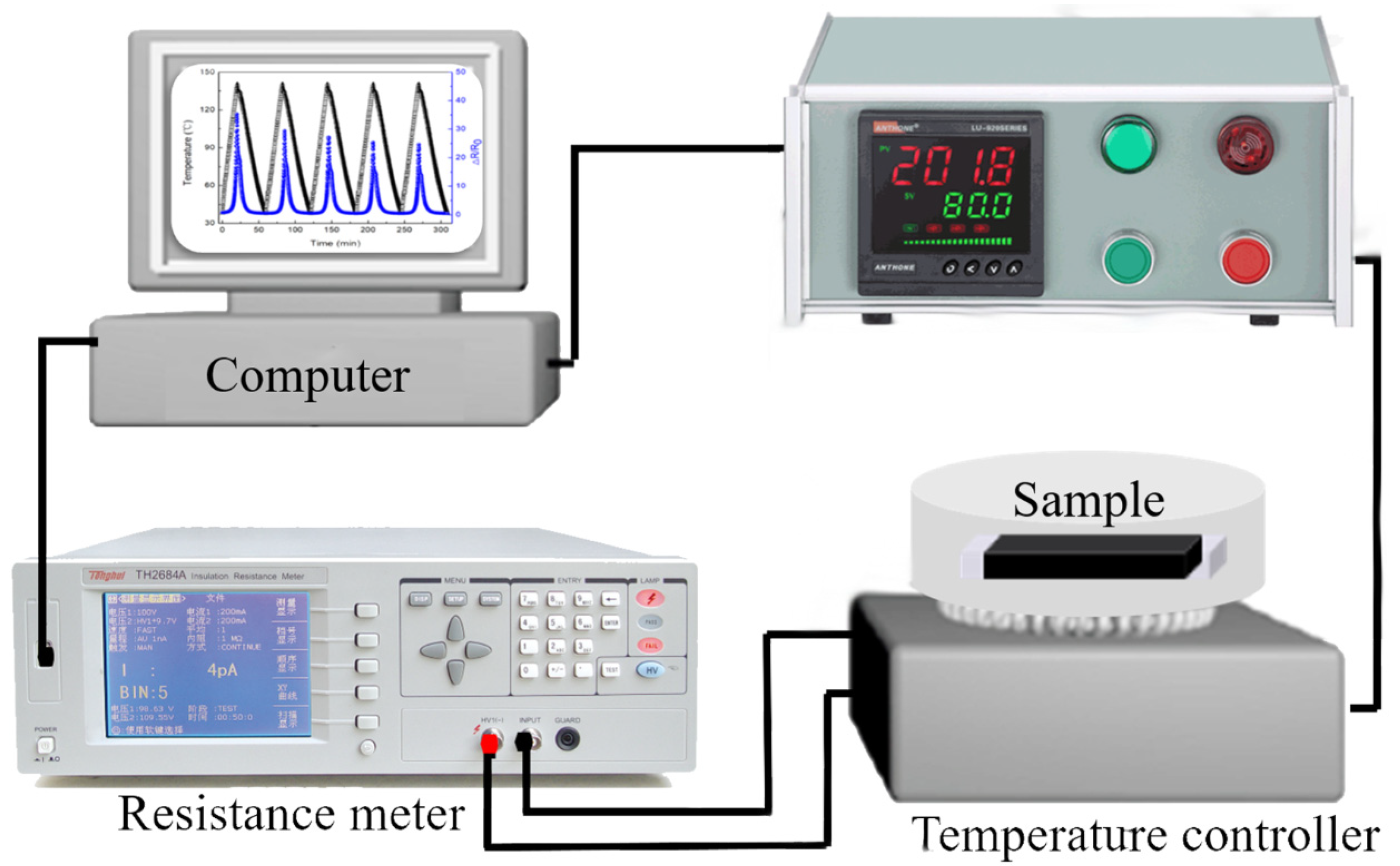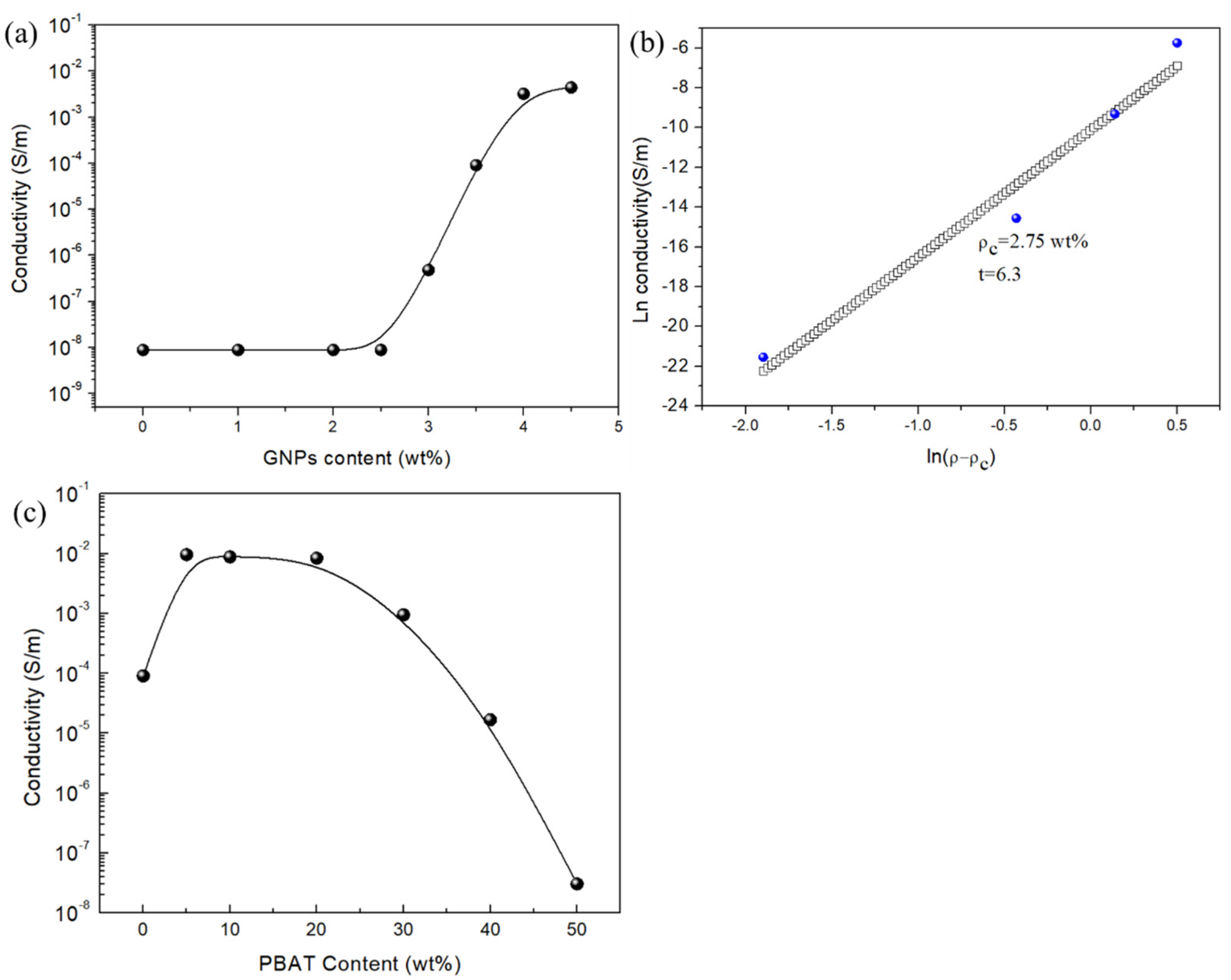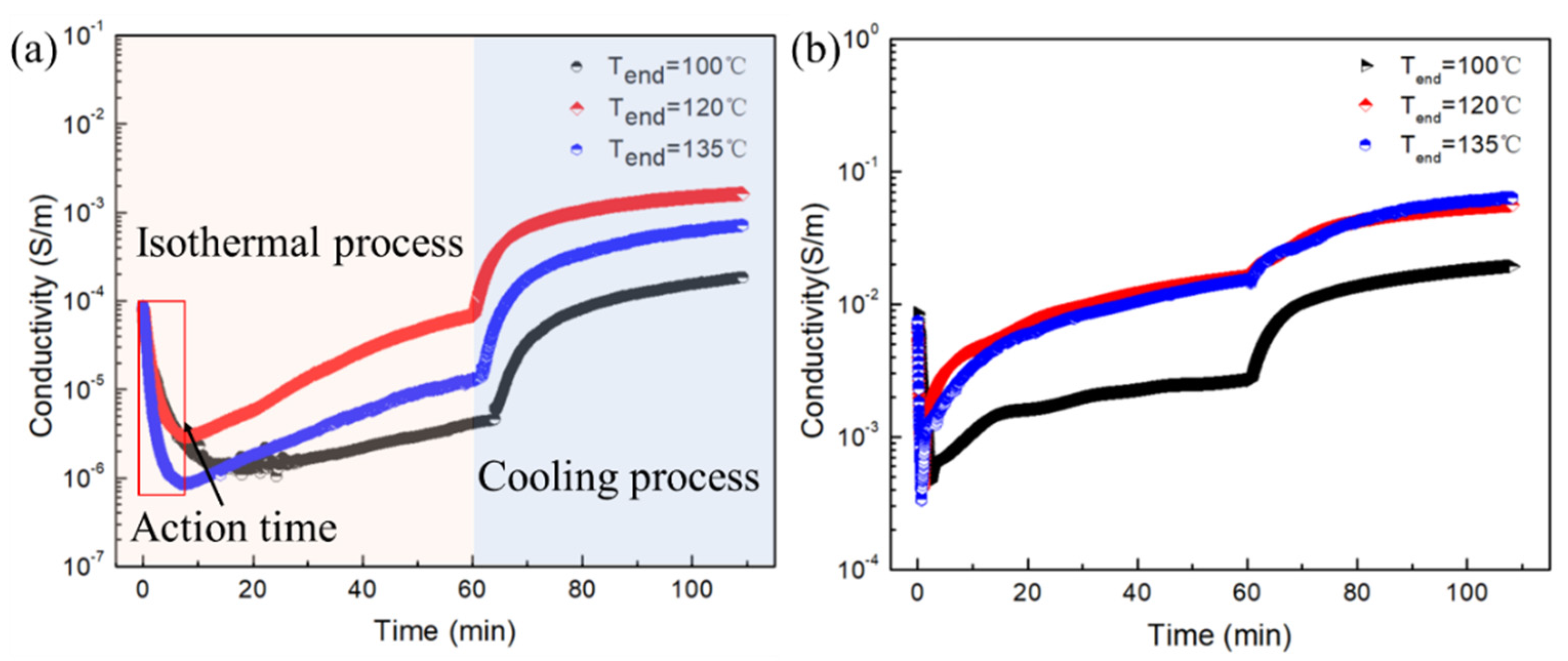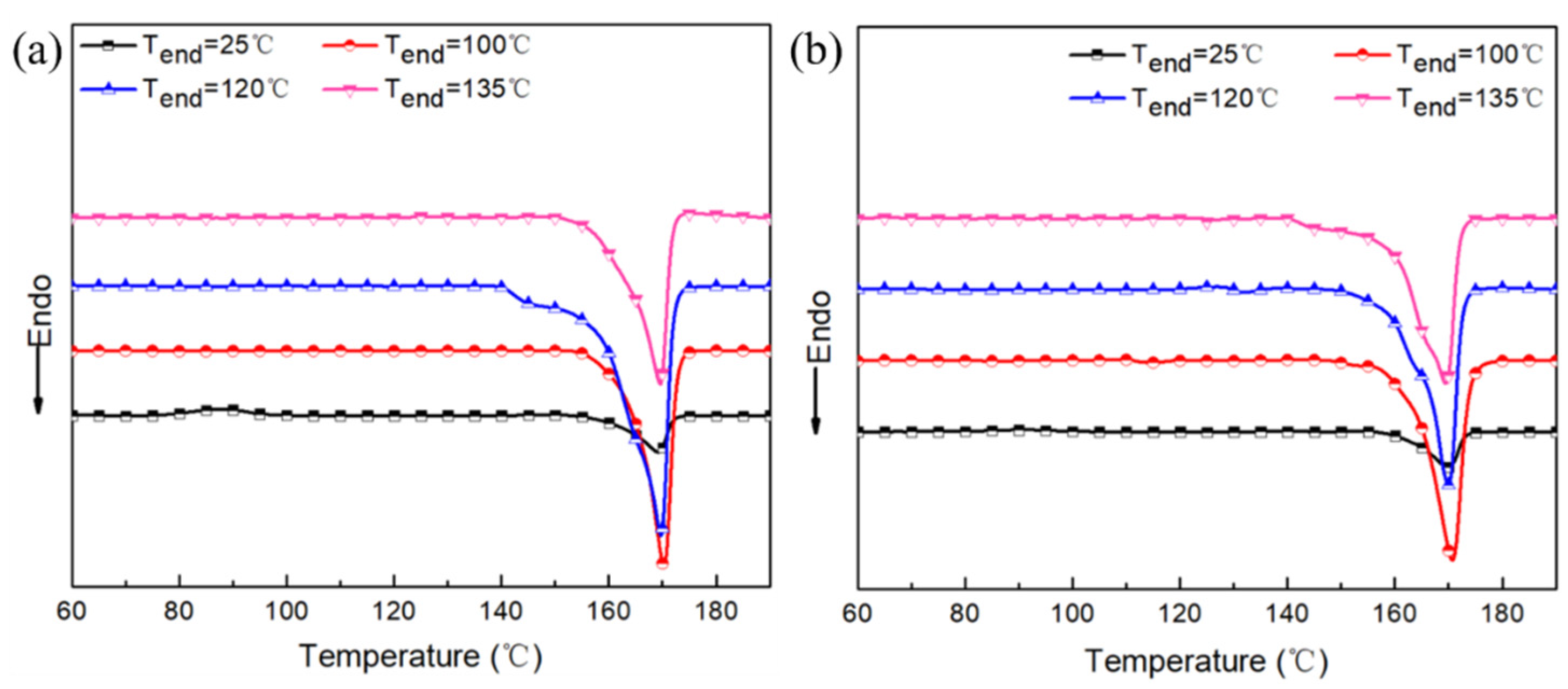High-Temperature Response Polylactic Acid Composites by Tuning Double-Percolated Structures
Abstract
:1. Introduction
2. Materials and Methods
2.1. Materials
2.2. Sample Preparation
2.3. Characterization
2.3.1. Scanning Electron Microscopy (SEM)
2.3.2. Differential Scanning Calorimetry (DSC)
2.3.3. Conductivity Testing
2.3.4. Temperature Response Behavior Analyses
3. Results and Discussion
3.1. Electrical Conductivity of CPCs
3.2. The Phase Morphology Analysis of CPCs
3.3. The Crystalline Properties of CPCs
3.4. The Isothermal Temperature Response of CPCs
3.5. The Non-Isothermal Temperature-Response Behaviors of CPCs
4. Conclusions
Author Contributions
Funding
Institutional Review Board Statement
Informed Consent Statement
Data Availability Statement
Conflicts of Interest
References
- Henry, A.; Plumejeau, S.; Heux, L.; Louvain, N.; Monconduit, L.; Stievano, L.; Boury, B. Conversion of Nanocellulose Aerogel into TiO2 and TiO2@C Nano-thorns by Direct Anhydrous Mineralization with TiCl4. Evaluation of Electrochemical Properties in Li Batteries. ACS. Appl. Mater. Inter. 2015, 7, 14584–14592. [Google Scholar] [CrossRef] [PubMed]
- Hur, J.; Im, K.; Kim, S.W.; Kim, J.; Chung, D.Y.; Kim, T.H.; Jo, K.H.; Hahn, J.H.; Bao, Z.; Hwang, S. Polypyrrole/Agarose-based electronically conductive and reversibly restorable hydrogel. Acs. Nano 2014, 8, 10066–10076. [Google Scholar] [CrossRef] [PubMed]
- Pang, H.; Yan, D.X.; Bao, Y.; Chen, J.B.; CHen, C.; Li, Z.M. Super-tough conducting carbon nanotube/ultrahigh-molecular-weight polyethylene composites with segregated and double-percolated structure. J. Mater. Chem. 2012, 22, 23568–23575. [Google Scholar] [CrossRef]
- Wang, G.; Wang, L.; Mark, L.H.; Shaayegan, V.; Wang, G.; Li, H.; Zhao, G.; Park, C.B. Ultralow-Threshold and Lightweight Biodegradable Porous PLA/MWCNT with Segregated Conductive Networks for High-Performance Thermal Insulation and Electromagnetic Interference Shielding Applications. ACS. Appl. Mater. Inter. 2018, 10, 1195–1203. [Google Scholar] [CrossRef] [PubMed]
- Fugetsu, B.; Sano, E.; Sunada, M.; Sambongi, Y.; Shibuya, T.; Wang, X.; Hiraki, T. Electrical conductivity and electromagnetic interference shielding efficiency of carbon nanotube/cellulose composite paper. Carbon 2008, 46, 1256–1258. [Google Scholar] [CrossRef]
- Qi, X.D.; Jing, H.Y.; Nan, Z.; Ting, H.; Zuo, W.Z.; Kühnert, I.; Pötschke, P.; Wang, Y. Selective localization of carbon nanotubes and its effect on the structure and properties of polymer blends. Prog. Polym. Sci. 2021, 123, 101471. [Google Scholar] [CrossRef]
- Korhonen, J.T.; Hiekkataipale, P.; Malm, J.; Karppinen, M.; Ikkala, O.; Ras, R. Inorganic hollow nanotube aerogels by atomic layer deposition onto native nanocellulose templates. Acs. Nano 2011, 5, 1967. [Google Scholar] [CrossRef]
- Farjana, S.; Toomadj, F.; Lundgren, P.; Sanz-Velasco, A.; Naboka, O.; Enoksson, P. Conductivity-Dependent Strain Response of Carbon Nanotube Treated Bacterial Nanocellulose. J. Sens. 2013, 2013, 741248. [Google Scholar] [CrossRef] [Green Version]
- Hamedi, M.; Karabulut, E.; Marais, A.; Herland, A.; Nystrom, G.; Wagberg, L. Nanocellulose aerogels functionalized by rapid layer-by-layer assembly for high charge storage and beyond. Angew. Chem. Int. Ed. Engl. 2013, 52, 12038–12042. [Google Scholar] [CrossRef]
- Kang, Y.J.; Chun, S.J.; Lee, S.S.; Kim, B.Y.; Kim, J.H.; Chung, H.; Lee, S.Y.; Kim, W. All-solid-state flexible supercapacitors fabricated with bacterial nanocellulose papers, carbon nanotubes, and triblock-copolymer ion gels. Acs. Nano 2012, 6, 6400–6406. [Google Scholar] [CrossRef]
- Joshi, G.M.; Deshmukh, K. Conjugated polymer/graphene oxide nanocomposite as thermistor. In AIP Conference Proceedings; AIP Publishing LLC: Melville, NY, USA, 2015; Volume 1667, p. 050017. [Google Scholar]
- Yu, Y.X.; Huang, Q.F.; Rhodes, S.; Fang, J.Y.; An, L.N. SiCNO-GO composites with the negative temperature coefficient of resistance for high-temperature sensor applications. J. Am. Ceram. Soc. 2017, 100, 592–601. [Google Scholar] [CrossRef]
- Feng, C.P.; Wei, F.; Sun, K.Y.; Wang, Y.; Lan, H.B.; Shang, H.J.; Ding, F.Z.; Bai, L.; Yang, J.; Yang, W. Emerging Flexible Thermally Conductive Films: Mechanism, Fabrication, Application. Nano-Micro Lett. 2022, 14, 24–57. [Google Scholar] [CrossRef] [PubMed]
- Zhao, Z.; Zhou, S.; Quan, L.; Xia, W.; Fan, Q.; Zhang, P.; Chen, Y.; Tang, D. Polypropylene Composites with Ultrahigh Low-Temperature Toughness by Tuning the Phase Morphology, Ind. Eng. Chem. Res. 2022, 61, 15240–15248. [Google Scholar] [CrossRef]
- Khosravani, M.R.; Berto, F.; Ayatollahi, M.R.; Reinicke, T. Characterization of 3D-printed PLA parts with different raster orientations and printing speeds. Sci. Rep. 2022, 12, 1016. [Google Scholar] [CrossRef] [PubMed]
- Yu, B.; Zhao, Z.; Fu, S.; Meng, L.; Liu, Y.; Chen, F.; Wang, K.; Fu, Q. Fabrication of PLA/CNC/CNT conductive composites for high electromagnetic interference shielding based on Pickering emulsions method. Compos. Part A Appl. Sci. Manuf. 2019, 125, 105558. [Google Scholar] [CrossRef]
- Kallannavar, V.; Kattimani, S. Effect of temperature and porosity on free vibration characteristics of a doubly-curved skew laminated sandwich composite structures with 3D printed PLA core. Thin-Wall. Struct. 2023, 182, 110263. [Google Scholar] [CrossRef]
- Bai, B.C.; Kang, S.C.; Im, J.S.; Lee, S.H.; Lee, Y.S. Effect of oxy fluorinated multi-walled carbon nanotube additives on positive temperature coefficient/negative temperature coefficient behavior in high-density polyethylene polymeric switches. Mater. Res. Bull. 2011, 46, 1391–1397. [Google Scholar] [CrossRef]
- Asare, E.; Evans, J.; Newton, M.; Peijs, T.; Bilotti, E. Effect of particle size and shape on positive temperature coefficient (PTC) of conductive polymer composites (CPC)-a model study. Mater. Design. 2016, 97, 459–463. [Google Scholar] [CrossRef]
- Abazine, K.; Anakiou, H.; El Hasnaoui, M.; Graça, M.P.F.; Fonseca, M.A.; Costa, L.C.; Achour, M.E.; Oueriagli, A. Electrical conductivity of multiwalled carbon nanotubes/polyester polymer nanocomposites. J. Compos. Mater. 2016, 50, 3283–3290. [Google Scholar] [CrossRef]
- Xiang, Z.D.; Chen, T.; Li, Z.M.; Bian, X.C. Negative Temperature Coefficient of Resistivity in Lightweight Conductive Carbon Nanotube/Polymer Composites. Macromol. Mater. Eng. 2009, 294, 91–95. [Google Scholar] [CrossRef]
- Gong, S.; Zhu, Z.H.; Li, Z. Electron tunnelling and hopping effects on the temperature coefficient of resistance of carbon nanotube/polymer nanocomposites. Phys. Chem. Chem. Phys. 2017, 19, 5113–5120. [Google Scholar] [CrossRef] [PubMed]
- Zhao, S.; Lou, D.; Zhan, P.; Li, G.; Dai, K.; Guo, J.; Zheng, G.; Liu, C.; Shen, C.; Guo, Z. Heating-induced negative temperature coefficient effect in conductive graphene/polymer ternary nanocomposites with a segregated and double-percolated structure. J. Mater. Chem. C 2017, 5, 8233–8242. [Google Scholar] [CrossRef]
- Zhang, X.; Zheng, X.; Ren, D.; Liu, Z.; Yang, W.; Yang, M. Unusual positive temperature coefficient effect of polyolefin/carbon fiber conductive composites. Mater. Lett. 2016, 164, 587–590. [Google Scholar] [CrossRef]
- Wang, F.X.; Liang, W.Y.; Wang, Z.Q.; Yang, B.; He, L.; Zhang, K. Preparation and property investigation of multi-walled carbon nanotube (MWCNT)/epoxy composite films as high-performance electric heating (resistive heating) element. Express. Polym. Lett. 2018, 12, 285–295. [Google Scholar] [CrossRef]
- Li, G.; Hu, C.; Zhai, W.; Zhao, S.; Zheng, G.; Dai, K.; Liu, C.; Shen, C. Particle size induced tunable positive temperature coefficient characteristics in electrically conductive carbon nanotubes/polypropylene composites. Mater. Lett. 2016, 182, 314–317. [Google Scholar] [CrossRef]
- Pang, H.; Zhang, Y.C.; Chen, T.; Zeng, B.Q.; Li, Z.M. Tunable positive temperature coefficient of resistivity in an electrically conducting polymer/graphene composite. Appl. Phys. Lett. 2010, 96, 251907. [Google Scholar] [CrossRef]
- Wu, D.; Cheng, Y.; Feng, S. Crystallization Behavior of Polylactide/Graphene Composites. Ind. Eng. Chem. Res. 2013, 52, 6371–6379. [Google Scholar] [CrossRef]
- Sabzi, M.; Jiang, L.; Liu, F.; Ghasemi, I.; Atai, M. Graphene nanoplatelets as poly(lactic acid) modifier: Linear rheological behavior and electrical conductivity. J. Mater. Chem. A 2013, 1, 8253–8261. [Google Scholar] [CrossRef]
- Zhang, D.; Chi, B.; Li, B.; Gao, Z.W.; Du, Y.; Guo, J.B.; Wei, J. Fabrication of highly conductive graphene flexible circuits by 3D printing. Synth. Met. 2016, 217, 79–86. [Google Scholar] [CrossRef]
- Kergariou, C.D.; Saidani-Scott, H.; Perriman, A.; Scarapa, F.; Le, D.A. The influence of the humidity on the mechanical properties of 3D printed continuous flax fibre reinforced poly(lactic acid) composites. Compos. Part A Appl. Sci. Manuf. 2022, 155, 106805. [Google Scholar] [CrossRef]
- Zhao, Z.; Tang, D.; Jia, S.; Ai, T. Favorable formation of stereocomplex crystals in long-chain branched poly(L-lactic acid)/poly(D-lactic acid) blends: Impacts of melt effect and molecular chain structure. J. Mater. Sci. 2021, 56, 6514–6530. [Google Scholar] [CrossRef]
- Zhao, Z.; Zhou, S.; Ai, T.; Li, Y.; Yang, Q.; Jia, S.; Tang, D. Fabrication of highly electrically conductive polypropylene/polyolefin elastomer/multiwalled carbon nanotubes composites via constructing ordered conductive network assisted by die-drawing process. J. Appl. Polym. Sci. 2022, 139, e52939. [Google Scholar] [CrossRef]
- Kashi, S.; Kashi, S. Graphene Nanoplatelet-Based Nanocomposites: Electromagnetic Interference Shielding Properties and Rheology. Ph.D. Thesis, RMIT University, Melbourne, Australia, 2017. [Google Scholar]







| Sample | T0 (°C) | Tp (°C) | T1/2 (min) | Sample | T0 (°C) | Tp (°C) | T1/2 (min) |
|---|---|---|---|---|---|---|---|
| PLA | 116.7 | 93.2 | 35.8 | PLAGNP3.5PB20 | 120.9 | 90.3 | 36.0 |
| PLAGNP3.5 | 130.8 | 118.2 | 27.3 | PLAGNP3.5PB30 | 120.6 | 97.6 | 34.1 |
| PLAGNP3.5PB5 | 112.9 | 96.0 | 34.8 | PLAGNP3.5PB40 | 125.3 | 97.2 | 33.5 |
| PLAGNP3.5PB10 | 110.7 | 93.8 | 35.7 | PLAGNP3.5PB50 | 125.3 | 98.8 | 33.2 |
| Heat Treatment Temperature | Initial Conductivity (10−5 S/m) | Minimum Conductivity (10−6 S/m) | Action Time (min) | Relative Crystallinity (%) | ||||
|---|---|---|---|---|---|---|---|---|
| a | B | a | b | a | b | a | b | |
| Tend = 25 °C | 27.4 | 32.5 | ||||||
| Tend = 100 °C | 6.99 | 862 | 1.37 | 460 | 14.15 | 2.19 | 44.3 | 35.0 |
| Tend = 120 °C | 8.42 | 711 | 2.97 | 410 | 7.25 | 1.00 | 52.3 | 46.8 |
| Tend = 135 °C | 8.72 | 700 | 8.61 | 332 | 7.77 | 0.69 | 50.3 | 46.0 |
Disclaimer/Publisher’s Note: The statements, opinions and data contained in all publications are solely those of the individual author(s) and contributor(s) and not of MDPI and/or the editor(s). MDPI and/or the editor(s) disclaim responsibility for any injury to people or property resulting from any ideas, methods, instructions or products referred to in the content. |
© 2022 by the authors. Licensee MDPI, Basel, Switzerland. This article is an open access article distributed under the terms and conditions of the Creative Commons Attribution (CC BY) license (https://creativecommons.org/licenses/by/4.0/).
Share and Cite
Yao, H.; Xue, R.; Wang, C.; Chen, C.; Xie, X.; Zhang, P.; Zhao, Z.; Li, Y. High-Temperature Response Polylactic Acid Composites by Tuning Double-Percolated Structures. Polymers 2023, 15, 138. https://doi.org/10.3390/polym15010138
Yao H, Xue R, Wang C, Chen C, Xie X, Zhang P, Zhao Z, Li Y. High-Temperature Response Polylactic Acid Composites by Tuning Double-Percolated Structures. Polymers. 2023; 15(1):138. https://doi.org/10.3390/polym15010138
Chicago/Turabian StyleYao, Haiwei, Rong Xue, Chouxuan Wang, Chengzhi Chen, Xin Xie, Pengfei Zhang, Zhongguo Zhao, and Yapeng Li. 2023. "High-Temperature Response Polylactic Acid Composites by Tuning Double-Percolated Structures" Polymers 15, no. 1: 138. https://doi.org/10.3390/polym15010138





